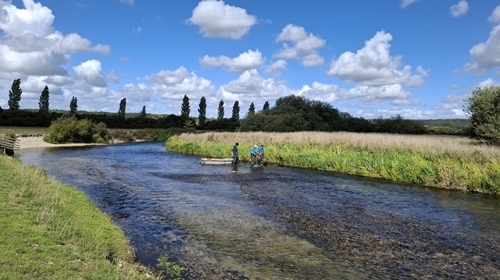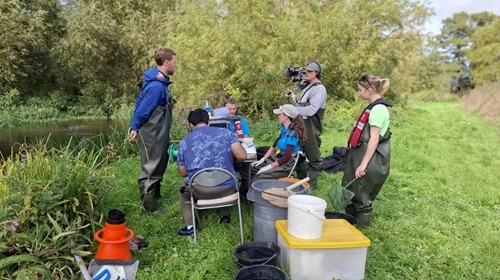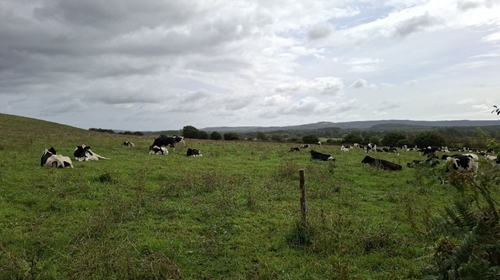Experts believe we can stop wild salmon from going extinct in our rivers – but we need to act now and we need to work together on a catchment scale.
The Game & Wildlife Conservation Trust (GWCT) and others have been monitoring wild Atlantic salmon numbers on the River Frome in Dorset for more than 50 years. Our work over the last two decades has helped us better understand the health and lifecycle of this iconic species, what is needed for it to spawn, hatch successfully and thrive in this 30-mile long chalk stream in the south-west of England. However, most importantly it has helped us identify the measures needed if we want to save it and stop salmon from disappearing from our rivers forever.
Wild Atlantic salmon have inhabited our UK rivers for millions of years, since when our present day south coast was hundreds of miles inland and we were still attached to continental Europe. They hatch in our rivers in early spring and spend a year, or occasionally two, living here before starting their migration to sea. A year or two later they return, swim up river to find their way back to where they once hatched, which is where they spawn.
Sadly in the past 40 we have seen wild salmon stocks decline sharply by about 80%. In another 30 years, these iconic, prehistoric fish could be completely gone from our rivers.
As part of the GWCT monitoring work on the Frome, we catch juvenile salmon – known as parr – over a period of four weeks in late summer. They are fitted with microchips and released back into the river in a bid to map their movements, growth and see how many survive in the river and at sea. Our researchers have nearly always been able to catch 10,000 parr.
Despite surveying the same areas of river, in 2024 we saw this figure drop by more than half – they only managed to scrape together 4,593 salmon parr.
This year was even worse – between 22 August and 17 September we only managed to find and tag 3,226 juvenile salmon.

ITV News reported on our findings during its lunchtime and evening news programmes on 19 September: Scientists fear the rapid decline of salmon in the UK - Latest From ITV News
Dylan Roberts, Head of Fisheries at GWCT, says: “Since 2002, using similar methods over similar lengths of the river, some 10,000 juvenile salmon have been caught annually and individually tagged as part of this detailed research programme on Frome salmon.
“In 2016 we had a one-off poor year where we could only catch and tag 4,953. However, in 2024 we only caught 4,593 and in 2025 we have now had a second consecutive very low year, only catching 3,226.
“This is alarming, but sadly reflective of what’s happening in other rivers in the UK and more widely in Europe. Almost all salmon rivers in England and Wales are classified as at risk by the Government bodies. This aligns with the wider national and international concerns around salmon abundance, where in December 2023 the IUCN reclassified salmon as Endangered in the UK after a 50% decline in the last 20 years
“The issues for salmon are many and complex. The are facing much tougher conditions in the marine environment, where global warming and concerns over bycatch are posing serious threats. But if we are able to improve conditions in our rivers, and make sure they can grow fitter, larger and stronger and reproduce in greater numbers, they will stand a better chance, once they migrate to sea, of returning in larger numbers.
“My team has seen first-hand the changes to the physical nature of the river Frome. In recent years, we have seen a huge increase in the growth of algae between spring and autumn which smothers the riverbed, shades and then reduces the growth of plants like water crowfoot, which are crucial habitats for juvenile salmon and the insects upon which they feed. Also, increases in the quantity of sediment which is mud running from riverbanks and ploughed fields into the river which smothers and suffocates salmon eggs.
“Excessive algae, also reduces the amount of oxygen available to fish in rivers at night and especially during the warmer months, this can stress, reduce the growth of and even kill fish. The algae grows excessively due to high levels of nutrients - nitrate and phosphate which are released into rivers from sewage, septic tank discharges and running off agricultural land.
“To create a better future for salmon, we need to tackle these issues together and at scale. To date, projects have been too small and patchy - mainly due to a lack of funding and bureaucratic challenges around farming and conservation - to make the changes needed.”
There are a number of other organisations striving to do good things on rivers and we don’t want to be another group doing our own thing. We need to work collaboratively with everyone in the sector, from councils, government bodies and NGO’s like the Wildlife Trusts and the Farming and Wildlife Advisory Group.

Farmers and scientists working together
Working with farmers is key. GWCT recognises that the UK will not meet environmental challenges such as river pollution and species recovery without working with farmers who manage 72% of the land. Moreover, conservation needs to be on landscape scale to achieve nature recovery. That’s why the Trust developed the Farmer Cluster concept in 2012, facilitating groups of contiguous landholders to work together to save threatened species in their local area.
In 2022 the Trust supported the launch of the farmer led cooperative Environmental Farmers Group (EFG) which acts as an umbrella group for farmer clusters and individual farms looking to access funding for habitat improvement and emissions reduction projects. It currently represents 541 farmers over an area of 341,404 hectares with groups in the South East, South West, Midlands and Yorkshire providing a blueprint mechanism for helping deliver national targets on net zero, biodiversity recovery and clean rivers.
Besides damage caused by agricultural activities, other serious causes of river pollution include sewage discharges by water companies, leakage from septic tanks near rivers and industrial pollution. The EFG’s scale and collaborative approach has the power to create partnerships to tackle big conservation challenges buy bringing together farmer clusters, local communities, water companies, charities and government agencies.
It is currently developing integrated catchment scale conservation plans for the Frome, Avon and Test and Itchen catchments, which will offer public and private investors the opportunity to support the recovery of some of our most treasured countryside.
Ian Baggs and Andrew Booth are both dairy farmers who farm by or near the River Frome - an area covered by EFG Dorset. They are both part of their local farmer clusters.
Ian Baggs is based along the banks of the Frome near Wareham. His dairy herd grazes the water meadows and fields near the river.
He says: “I believe farmers are custodians of the land and we have an obligation to do the right thing. It’s about securing the long-term sustainability of farming and the future of generations to come.
“For decades we used to grow maize on this field above the river, where the land slopes down towards it. We have now changed that, instead we’ve planted deep rooted grass and instead graze the cows on it. This stops the problem of run off and helps improve the river, reducing the amount of silt reaching it.
“We also keep cattle moving to fresh pastures every few days, to allow the environment to recover quicker.”
“I’m happy to look at doing more, in fact I want to do more, and I’m always looking at ways of improving the health of the river, but like many I need adequate financial support and expert guidance. That’s why farmer clusters, EFG and the science based advice of the GWCT is vital.”

Andrew Booth farms near Dorchester on the banks of a tributary to the Piddle, another chalkstream near the Frome.
His cluster group of 10 farmers, which he chairs, has constructed grips, silt traps for catching road sediment, and has fenced off the riverbank along the brook, to prevent it from becoming eroded by cattle. Fields are cultivated horizontally on hillsides to prevent gaps between drillings and the tram lines acting as drains. They are also considering mitigating run off from maize fields by sowing grass between rows to hold the soil after harvest.
Andrew says: “The strength of EFG is that it is formed from smaller groups of farmer clusters like our own Devils’ Brook and Chesel Cluster. Our farms border each other so a conservation measure by one can benefit all at nature is interconnected.
“We also have a strong sense of ownership and responsibility for our bit of river and local wildlife. The group is naturally linked with the local community and brings an important social aspect. It’s enabled us to access bits of funding we wouldn’t have qualified for as individual farmers to carry out habitat improvement work including cleaning up our stretch of the river.
“Like other farmer clusters in Hampshire and Wiltshire we have started our own water quality monitoring and it has shown some improvement, but there is more that could be done.”
Colin Smart, from the Environmental Farmers Group Dorset, says: “We are planning to develop a catchment conservation plan for the Frome with advice and input from GWCT fisheries. As part of that we are surveying the length of the River Frome to build a picture of where we can make improvements.
“With a sufficient blend of investment from both the private and public sector, the catchment plan has the potential to reverse the catastrophic decline of salmon in the Frome, which is an indication of the poor health of the entire river system.
“Farmers do care about the environment and can make a real difference but also need to produce food and make a living. They need adequate compensation to put the right measures in place.”
Clare Scott, facilitator for the Devil and Chesel Farmer Cluster on behalf of FWAG South West (FWAGSW), says: “The aim of the cluster is to improve water quality and river habitats across the catchment. Over the past few years, farmers have implemented a suite of measures - supported by funding from Defra’s Farming in Protected Landscapes programme, the Environment Agency, and The Tree Council - that help reduce and intercept sediment and surface run-off. These interventions have been complemented by changes to in-field farming practices that enhance soil health, increase water retention, and reduce downstream flood risk.
“As facilitators, FWAGSW ensures that farmers have access to industry expertise and best practice guidance. Working together promotes group discussion and provides opportunities to share ideas and learning.”